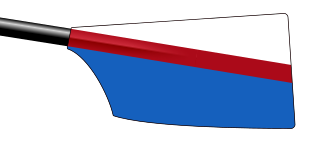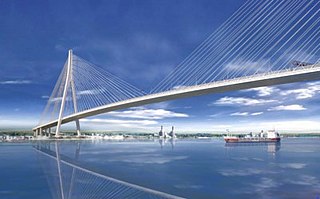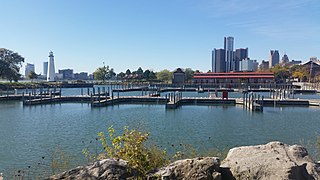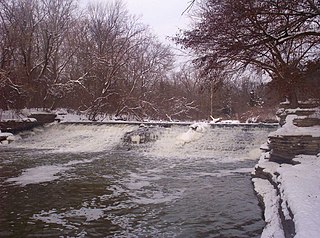 W
WThe Detroit River flows west and south for 24 nautical miles from Lake St. Clair to Lake Erie as a strait in the Great Lakes system. The river divides the metropolitan areas of Detroit, Michigan, and Windsor, Ontario — an area collectively referred to as Detroit–Windsor — and forms part of the border between Canada and the United States. The Ambassador Bridge, the Detroit–Windsor Tunnel, and the Michigan Central Railway Tunnel connect the cities.
 W
WThe Ambassador Bridge is a tolled suspension bridge across the Detroit River that connects Detroit, Michigan, United States, with Windsor, Ontario, Canada. It is the busiest international border crossing in North America in terms of trade volume, carrying more than 25% of all merchandise trade between the United States and Canada. A 2004 Border Transportation Partnership study showed that 150,000 jobs in the region and US$13 billion in annual production depend on the Detroit–Windsor international border crossing.
 W
WDetroit is the largest and most-populous city in the U.S. state of Michigan, the largest U.S. city on the United States–Canada border, and the seat of Wayne County. The municipality of Detroit had a 2019 estimated population of 670,031, making it the 24th-most populous city in the United States. The metropolitan area, known as Metro Detroit, is home to 4.3 million people, making it the second-largest in the Midwest after the Chicago metropolitan area, and 14th-largest in the United States. Regarded as a major cultural center, Detroit is known for its contributions to music and as a repository for art, architecture and design.
 W
WThe Detroit Boat Club was established in 1839, as a sport rowing club. It was first created on the Detroit River during a time in which Detroit was just starting to grow. The Detroit Boat Club is a member of the Detroit Regional Yacht-racing Association (DRYA).
 W
WThe Detroit International Riverfront is a tourist attraction and landmark of Detroit, Michigan extending from the Ambassador Bridge in the west to Belle Isle in the east, for a total of 5.5 miles. The International Riverfront encompasses a cruise ship passenger terminal and dock, a marina, a multitude of parks, restaurants, retail shops, skyscrapers, and high rise residential areas along with TCF Center. The Marriott at the Renaissance Center and the Robert's Riverwalk Hotel are also situated along the International Riverfront. Private companies and foundations together with the city, state, and federal government have contributed several hundred million dollars toward the riverfront development. Key public spaces in the International Riverfront, such as the RiverWalk, Dequindre Cut Greenway and Trail, William G. Milliken State Park and Harbor, and a cruise ship passenger terminal and dock at Hart Plaza complement the architecture of the area. The area provides a venue for a variety of annual events and festivals including the Detroit Electronic Music Festival, Detroit Free Press International Marathon, the Detroit International Jazz Festival, Motor City Pride, the North American International Auto Show, River Days and Detroit China Festival.
 W
WThe Detroit River International Wildlife Refuge is the only international wildlife refuge in North America. Established in 2001 and managed jointly by the United States Fish and Wildlife Service and the Canadian Wildlife Service, it is in the heart of a major metropolitan area. Detroit River International Wildlife Refuge is one of over 540 National Wildlife Refuges managed by the U.S. Fish and Wildlife Service within the Department of the Interior. It occupies 7.88 square miles (20.42 km2) of scattered property but has drawn boundaries for further expansion.
 W
WThe Detroit Water and Sewerage Department (DWSD) is a public utility that provides water and sewerage services for Detroit, Michigan and owns the assets that provide water and sewerage services to 126 other communities in seven counties. It is one of the largest water and sewer systems in the United States. In 2000, the utility utilized five water treatment plants using water from the Detroit River and Lake Huron. In mid 2014, the DWSD had acquired significant debt and delinquent accounts, and talks of privatization were occurring. As of January 1, 2016, under the terms of the City of Detroit's municipal bankruptcy the Great Lakes Water Authority (GLWA) was created with a $50 million annual lease agreement to the City of Detroit for 40 years, while the DWSD bifurcated to focus its services specifically on the water and sewer customers within only the city of Detroit.
 W
WThe Detroit–Windsor region is an international transborder agglomeration comprising the American city of Detroit, Michigan, the Canadian city of Windsor, Ontario, and the Detroit River between them. The Detroit–Windsor area acts as a critical commercial link straddling the Canada–United States border and has a total population of about 5,700,000. It is North America's largest cross-border conurbation.
 W
WThe Detroit–Windsor tunnel, also known as the Detroit–Canada tunnel, is an international highway tunnel connecting the cities of Detroit, Michigan, United States and Windsor, Ontario, Canada. It is the second-busiest crossing between the United States and Canada, the first being the Ambassador Bridge, which also connects the two cities.
 W
WDowntown Detroit is the central business district and a residential area of the city of Detroit, Michigan, United States. Locally, downtown tends to refer to the 1.4 square mile region bordered by M-10 to the west, Interstate 75 to the north, I-375 to the east, and the Detroit River to the south. Although, it may also refer to the Greater Downtown area, a 7.2 square mile region that includes surrounding neighborhoods such as Midtown, Corktown, Rivertown, and Woodbridge.
 W
WThe Ecorse River is an 18.8-mile-long (30.3 km) river in southern Michigan. Because of its small size, it is often identified as Ecorse Creek. It flows through the Downriver section of Metro Detroit, and is a tributary of the Detroit River. The early French settlers named it the Rivière aux Écorces. They named the river after the custom they observed of the local Native American tribe, who wrapped their dead in birch or elm bark, and buried them at the mouth of the river. The river has two branches, which meet at Council Point Park in the city of Lincoln Park, where chief Pontiac held a council in 1763 before attacking Fort Detroit.
 W
WElizabeth Park is a county park mostly located on an artificial island in the Detroit River in southern Wayne County, Michigan. The park is sometimes but rarely referred to as Slocum's Island — the historic name of the island on which the park is located. The park is located within the city limits of Trenton along Jefferson Avenue and just north of the Wayne County Bridge leading to Grosse Ile. Elizabeth Park is recognized as the first county park established in the state of Michigan.
 W
WFort Pontchartrain du Détroit or Fort Detroit was a fort established on the west bank of the Detroit River by the French officer Antoine de la Mothe Cadillac in 1701. In the 18th century, French colonial settlements developed on both sides of the river, based on the fur trade, missions and farms.
 W
WThe Gordie Howe International Bridge, known during development as the Detroit River International Crossing and the New International Trade Crossing, is a cable-stayed international bridge across the Detroit River currently under construction. The crossing will connect Detroit and Windsor by linking Interstate 75 and Interstate 96 in Michigan with Highway 401 in Ontario. The bridge will provide uninterrupted freeway traffic flow, as opposed to the current configuration with the nearby Ambassador Bridge which connects to city streets on the Ontario side. The bridge is named after Canadian ice hockey player Gordie Howe, who was best known for his tenure with the Detroit Red Wings of the National Hockey League.
 W
WThe Grosse Ile Toll Bridge is a swing bridge that crosses the Trenton Channel of the Detroit River connecting Grosse Ile Township, Michigan to the mainland in Riverview, Michigan which is located in Wayne County, Michigan.
 W
WGrosse Pointe Park is a city in Wayne County in the U.S. state of Michigan. The population was 11,555 at the 2010 census. Bordering on Detroit with frontage on southern Lake Saint Clair, it is the westernmost of the noted Grosse Pointe suburbs, with the oldest overall housing stock of the five cities. Grosse Pointe Park is 6 miles (9.7 km) east of downtown Detroit and thus is home to many who commute to the city on a daily basis. The area is often referred to simply as 'GPP' or "The Park".
 W
WJ. W. Westcott II is a boat known for its delivery of mail to ships while they are underway. It operates out of Detroit, Michigan, and is the only floating ZIP Code in the United States.
 W
WLake St. Clair is a freshwater lake that lies between the Canadian province of Ontario and the U.S. state of Michigan. It was named in 1679 by French Catholic explorers after Saint Clare of Assisi, on whose feast day they first sighted this body of water.
 W
WThe MacArthur Bridge is a bridge that spans the Detroit River between Detroit, Michigan and Belle Isle. The bridge, which features nineteen total arches across 2,193 feet (668 m), provides main access to Belle Isle. Completed in 1923 for $2.635 million USD, it replaced an iron bridge with wooden decking that accidentally caught fire and was destroyed in 1915. The bridge, popularly known as the Belle Isle Bridge, was originally named the George Washington Bridge and later renamed the Douglas MacArthur Bridge after General Douglas MacArthur in 1942. It was restored in 1986 at a cost of $11.5 million.
 W
WThe Michigan Central Railway Tunnel is a railroad tunnel under the Detroit River connecting Detroit, Michigan, in the United States with Windsor, Ontario, in Canada. The U.S. entrance is south of Porter and Vermont streets near Rosa Parks Boulevard. The Canadian entrance is south of Wyandotte Street West between Cameron and Wellington Avenues. It was built by the Detroit River Tunnel Company for the Canada Southern Railway, leased by the Michigan Central Railroad and owned by the New York Central Railroad. The tunnel opened in 1910 and is still in use today by the Canadian Pacific Railway. On the Detroit side, the area around the tunnel is off limits to the general public and is routinely patrolled by officers and agents of the U.S. Department of Homeland Security, Canadian Pacific Police Service, CN Police, Detroit Police Department, and the security elements of the bridge company.
 W
WThe William G. Milliken State Park and Harbor is a public recreation area located on the Detroit River just east of downtown Detroit, Michigan, on a portion of the city's International Riverfront. The state park's 31 acres (13 ha) include wetlands, paved trails, and a 52-slip harbor of refuge. A 63-foot (19 m) conical brick lighthouse tower, designed as a scaled-down replica of the Tawas Point Light, marks the harbor entrance.
 W
WPointe Mouillee State Game Area is a state game area in the U.S. state of Michigan. It encompasses 7,483 acres (30.3 km2) of hunting, recreational, and protected wildlife and wetland areas at the mouth of the Huron River at Lake Erie, as well as smaller outlying areas within the Detroit River. Pointe Mouillee State Game Area was established in 1945 and is administered by the Michigan Department of Natural Resources.
 W
WThe River Rouge is a 127-mile river in the Metro Detroit area of southeastern Michigan. It flows into the Detroit River at Zug Island, which is the boundary between the cities of River Rouge and Detroit.
 W
WRiver Rouge is a city in Wayne County in the U.S. state of Michigan. The population was 7,903 at the 2010 census. It is named after the River Rouge, which flows along the city's northern border and into the Detroit River. The city includes the heavily industrialized Zug Island at the mouth of the River Rouge.
 W
WRiverfront Towers is an apartment and condominium complex of three high rise residential skyscrapers along the International Riverfront in Detroit, Michigan, United States. Each Riverfront Tower creates an ascending tier of three towers.
 W
WRiverview is a city in Wayne County, Michigan. The population was 12,486 at the time of the 2010 census.
 W
WThe Siege of Fort Detroit was an ultimately unsuccessful attempt by North American Indians to capture Fort Detroit during Pontiac's Rebellion. The siege was led primarily by Pontiac, an Ottawa chief and military leader. This rebellion would be one of the catalysts that hastened the declaration of the Proclamation of 1763 which would eventually precipitate the events leading to the American Revolution.
 W
WThe Wayne County Bridge is a swing bridge that crosses the Trenton Channel in the Detroit River. Located in Wayne County, Michigan, it connects Grosse Ile Township to mainland Trenton and is one of two bridges connecting the island of Grosse Ile to the mainland — the other being the tolled Grosse Ile Toll Bridge to the north. Locally, it is also known as "The Free Bridge".
 W
WThe Windsor Yacht Club (WYC) is a private yacht club in Windsor, Ontario. It is located on the Canadian mainland just south of Peche Island overlooking the Detroit River. The clubhouse overlooks the southern shore of Peche Island and is at the north-end of the Detroit River, which takes water from Lake St. Clair.
 W
WWindsor is a city in southwestern Ontario, Canada, on the south bank of the Detroit River directly across from Detroit, Michigan, United States. Located in Essex County, it is the southernmost city in Canada and marks the southwestern end of the Quebec City–Windsor Corridor. The city's population was 217,188 at the 2016 census, making it the third-most populated city in Southwestern Ontario, after London and Kitchener. The Detroit–Windsor urban area is North America's most populous trans-border conurbation, and the Ambassador Bridge border crossing is the busiest commercial crossing on the Canada–United States border.